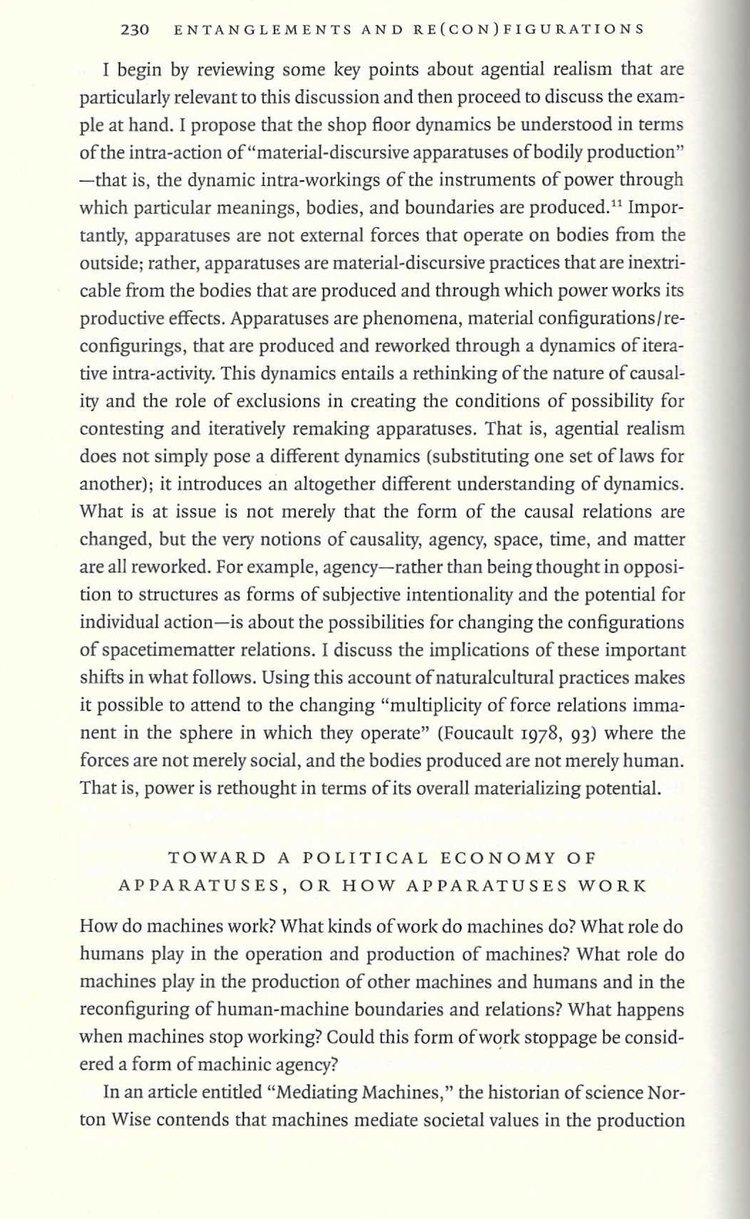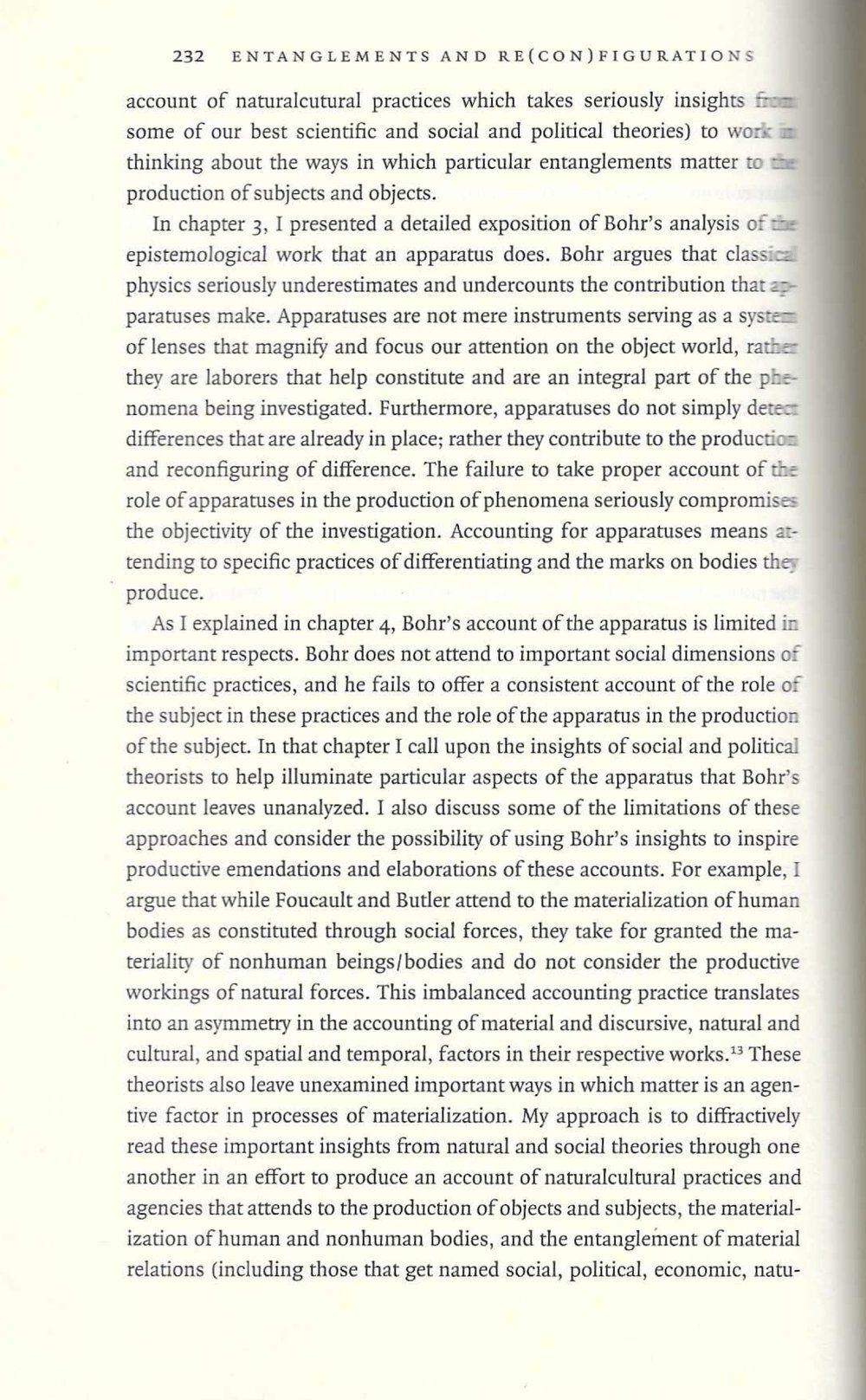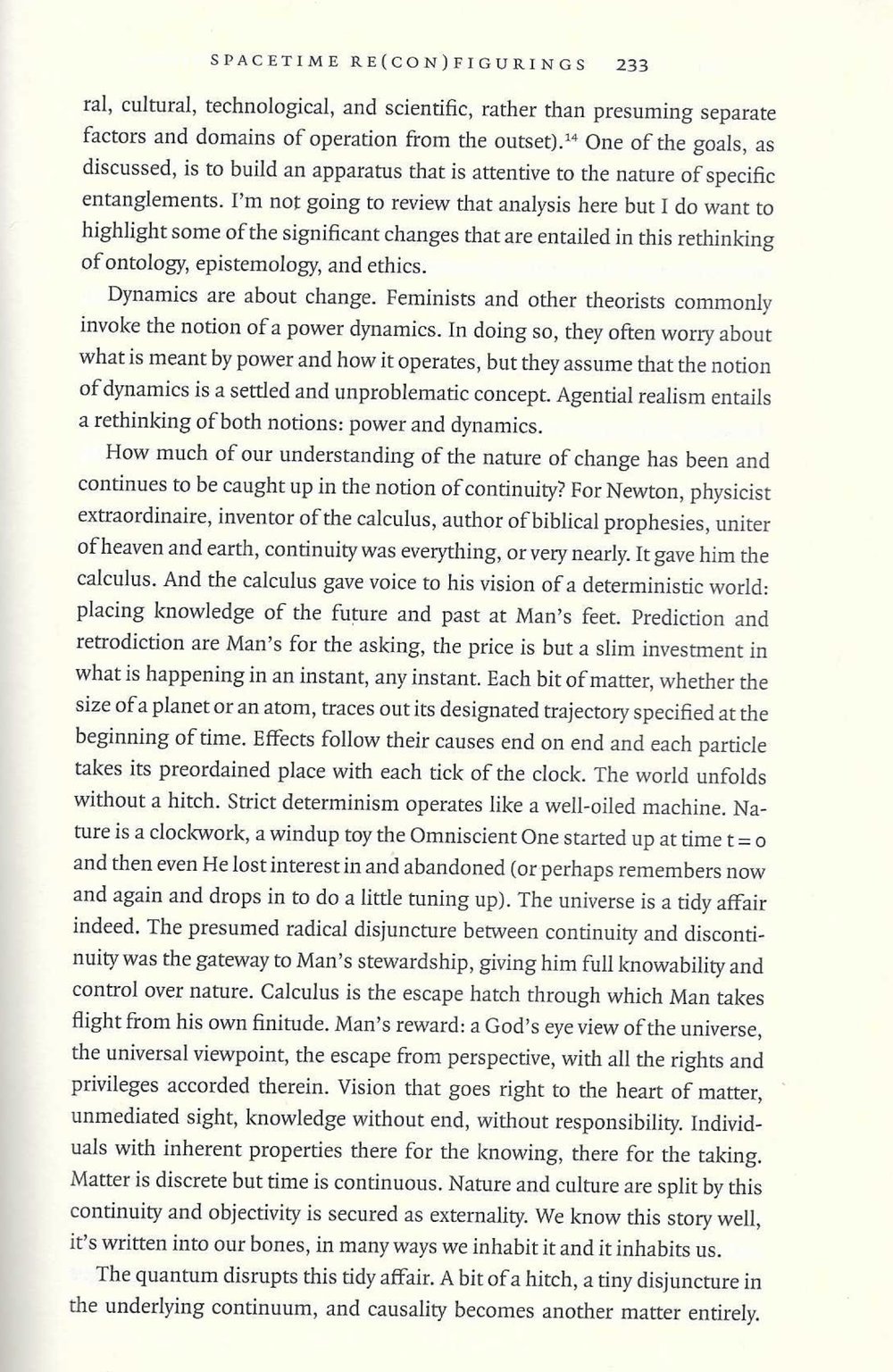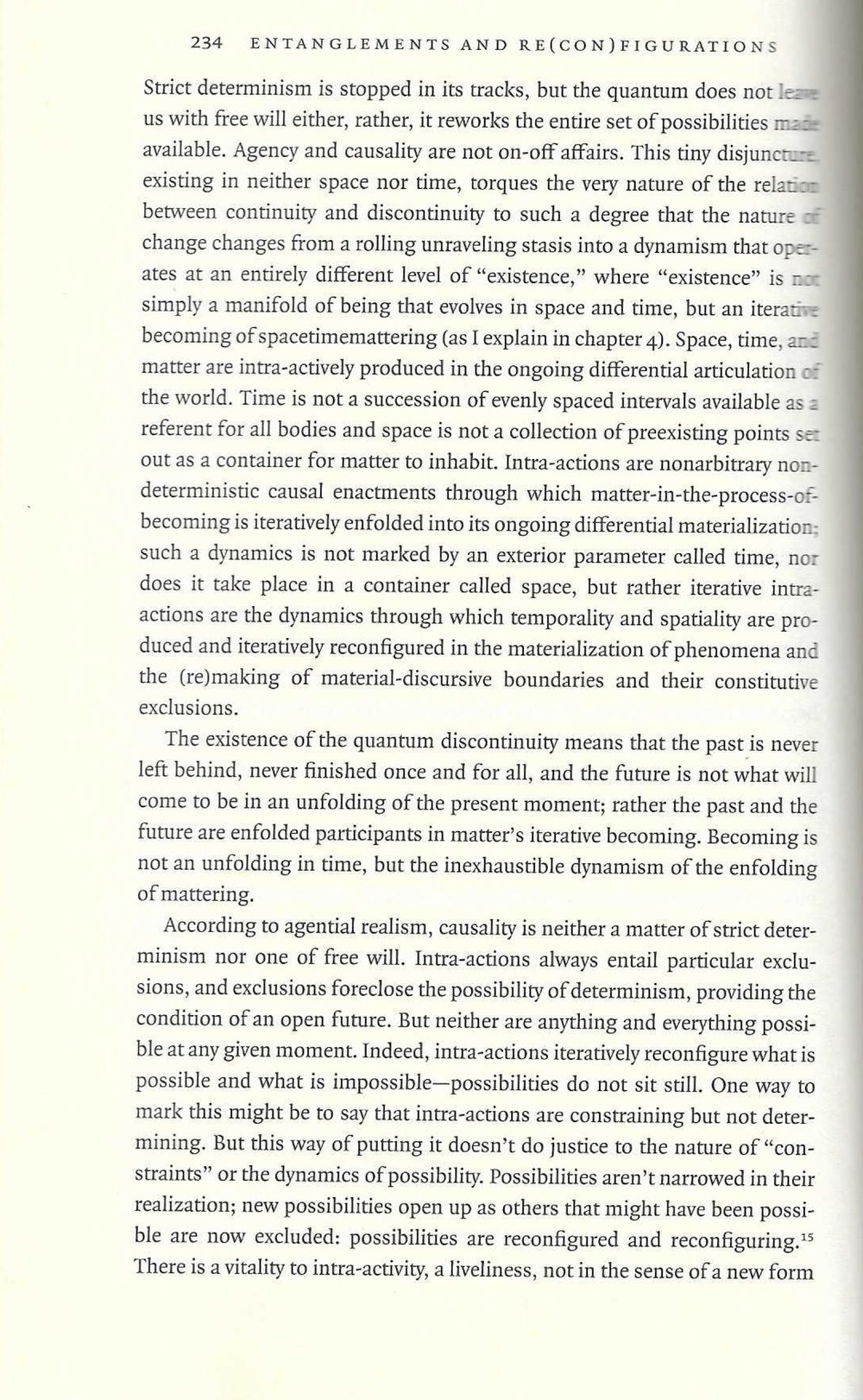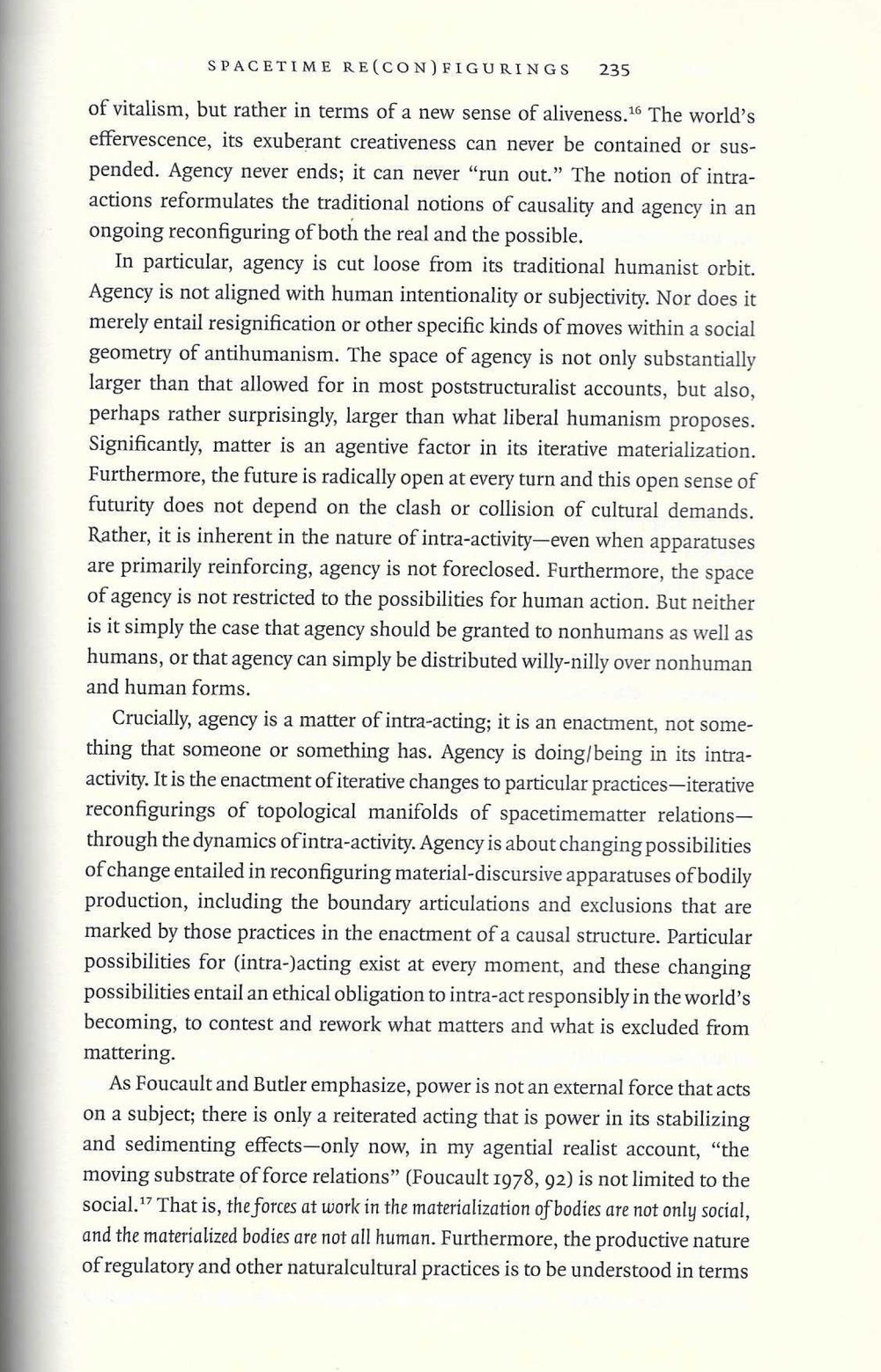A methodology based upon diffraction is an accounting attentive to detail, an inquiry of differences and relationalities, a study of the phenomenon of how subject and object emerge as a result of intra- activity (Barad, 2007).
I was recently asked by a Professor who was due to teaching a class on methodologies to write an accessible paragraph on why I am drawn to the physics-philosophy of Karen Barad. He thought some verbatim examples from artist-researchers might provide some insight for students into how Barad’s seemingly abstract ideas could be applied to artistic research.
Thinking back, I remember the sense of recognition and delight when introduced to Barad’s ideas by a North American artist-filmmaker in 2017. It really didn’t feel that abstract to me, since there was something about the relational, event-based philosophy of agential realism that already chimed with my way of looking at the world. I’ve subsequently discovered other thinkers who have some crossover with Barad in their critical approach, and of course there can be obstacles to fully decoding Barad’s arguments if you don’t have the physics background she comes from, but despite this, I’m still as attracted to her main metaphysical ideas as I was when I first read them. Here’s how I tried to sum it up for the Professor:
Exploring the tensions between perception and reality is key in my work and so my practice is already closely concerned with the relationship between the abstract and the concrete. I like to explore questions from science, phenomenology and metaphysics and Barad speaks to all these interests. Her connection to feminist (and ‘post’) theories is important to me as well.
I find Barad’s philosophy so radically relational that it blows my mind (forget about the atom, the event is the building block of the universe!). To ask what it would mean to take such an alternative perspective on reality seriously in the world - and see what it can do - is, for me, a really compelling line of enquiry. To question the primacy of objects without divorcing us from materiality - how refreshing! Granted, it takes a bit of getting used to. (I’m still not!)
I find diffraction a bit simpler to understand than some of Barad's other ideas. It asks us to acknowledge certain things are knowable only by obscuring others and vice versa. For me, this additive, respectful form of critique offers an alternative to the kind of macho one-upmanship which I find exclusionary, and which makes me want to kill someone, or abandon my PhD. Diffraction as a method can be a way of honouring difference and taking responsibility for the exclusions that will arise from your own contribution to research, at the same time as taking account of your intrinsic interdependence with and on others.
I then went back to a post I wrote and never published from 2019 when I was submitting my first PhD funding application and I was first thinking about diffraction. I wanted to see if my appreciation of the methodology has changed much since then, but I found what I had actually written about was a failed proposal for a work I made in 2018, which was based on Barad’s writing about scientific apparatuses. A tweaked version of the unpublished post follows along with some pages from Barad’s 2017 monograph ‘Meeting the Universe Halfway’.
———————————————————————-
2019
A methodology based upon diffraction is an accounting attentive to detail, an inquiry of differences and relationalities, a study of the phenomenon of how subject and object emerge as a result of intra- activity (Barad, 2007).
To read one thing diffractively through another, according to the physics-based philosophy of Karen Barad, is to pay rigorous attention to where the two things overlap and where they differ. It is an approach to criticality which attempts to take into account the way that different approaches, methods, or apparatuses of observation necessarily allow different aspects of the subject to emerge (and in fact Barad argues goes much further and argues that the observer, method of observation and subject cannot be definitively defined or separated and are therefore fundamentally involved in co-constituting each other).
“…diffraction proposes a criticality that examines and builds on contrasting modes of thought without automatically seeking to negate what has gone before or that which differs. Diffraction, then, is a radical departure in criticism, a less polarising mode of engagement that is capable of radically altering the way the cannon is constituted” (Gerts & van der Tuin, 2016).
How might a diffractive methodology be manifest through art practice? It’s an open question for me.
My piece ‘On Exactitude in Science’, 2018, and a proposed performative extension to the piece which was never enacted, attempted to grapple with some of these concepts (diffraction; apparatus theory). It’s a more directly conceptual artwork than I would normally make, and so I can speak more easily than usual to what it was ‘about’.
The title is a reference to the Borges essay on the absurdity of an imaginary one to one scale cartography, and the piece explores the limits of one kind of representation (cartography) through another (sculpture) to create a work purporting to take into account more fully the four dimensions involved in the process of mapping. Even here though, the complexity of the apparatus (the artist engaged in mapping of the studio floor with graphite and paper) cannot ever be fully described. The fractal complexity of experience means that the more you look in detail at any given moment in time the more you are forced to take into account. As with an examination of space: if greater and greater magnification is applied, the territory expands exponentially, so in any representation more is omitted than can ever be included. As with Borges’ map of the Empire, seeking ‘accuracy’ in any endeavour is intrinsically a partial affair.
To bring out this absurd aspect of the work, I once proposed an durational performance that would become an extension to the sculptural work, to be conducted for a residency at Market Gallery in Glasgow. My proposal was to sit in the studios, open to the public and to begin to record a vast appendix to the work. This appendix would describe the production apparatus of the work, as forming part of the work. As I wrote freely, brainstorming all the possible elements which made up this apparatus, the definition and boundaries of the artistic materials would expand to an exponentially absurd degree, expanding Borges’s 1:1 scale to include the infinity of fractal space. This work was in one way an expression of the conceptual hell of the information age, but it was also an acknowledgement of the fact that no artist can claim authorship of their work since the work is made by the world as much as it is by their actions within the world.
An example of an entry in this proposed appendix:
‘this part of the map was constructed on 1st March 2018, on which day the newspaper headlines read 'Hands off our borders' and 'whiteout Britain’ and in which the artist entered the first day of her menstrual cycle and ate weetabix for breakfast and was thinking about her recent breakup with S and on which day she had a small cut on her right middle finger which gathered some graphite dust’ and so on and so on.
Somewhat to my relief, the residency proposal was rejected by Market Gallery. I suspect a rejected proposal may be the most appropriate form for the work to occupy.


